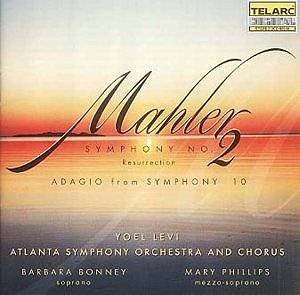Yoel Levi’s Mahler has always struck me as somewhat characterless, and this performance of Mahler’s Resurrection does not stray from that. There is little of the urgency associated with Klemperer, and virtually none of the flare which a Bernstein or a Sinopoli bring to this work. Taken at a very broad tempo indeed, this is Mahler which is wonderfully transparent in terms of textures but Mahler which lacks passion. An example of that superb transparency is the muted trumpet in the final movement (9’02 – 9’11) which moves from ff to ppp with an extraordinary feeling for dynamics. Rarely will you hear it better done.
The orchestral playing is indeed superlative. The brass are strident and tonally very well blended, though Levi is a sufficiently temperate conductor to keep their balance well controlled. Indeed, dynamically, this is a near perfect performance. Woodwind emerge clearly from the brass tuttis (a rarity in this symphony) although lower strings are somewhat anonymously placed. They lack the depth and bite of both the Philharmonia for Sinopoli or the New York Philharmonic for Bernstein.
Why this performance is so uninvolving, largely in the first four movements, is puzzling. Levi’s handling of the opening maestoso is far too brittle for my tastes. Rather like Ashkenazy (live with the Philharmonia) Levi builds up compelling climaxes but fails to place them preternaturally. At times, and aided by the spectacular recording Telarc give much of this recording, it feels like being hit by a juggernaut. Both the second and third movements lack sufficient electricity to compel the attention for long.
Where the performance really picks up is in the final movement, but only once the chorus enter (20’13). This is one of the great choruses currently performing today. Moments such as their long-breathed pianissimo entry are superlatively done. It is all the more unfortunate, then, that Telarc’s hitherto dynamic recording lets the chorus down in their exultant close where the balance dries out the voices to a damaging extent. It illustrates perfectly the controlled presentation of this entire performance.
The ‘filler’ on this set is the Adagio from Mahler’s Tenth. Again, the performance is paced too slowly but in this case this has one notable virtue: it underpins more dramatically than most performances the sparse orchestration of this work’s Mahlerian polyphony. I don’t think I have heard a performance which allies this music as closely to Berg as this one does. Woodwind from 17’09 to the solo violin at 17’19 are almost terrifyingly atonal. The handling of the climax at 19’27 is as sheerly terrifying as any you will hear, and made more thrilling given the incredibly plangent string dynamics which precede it. The playing is superlative, notably from the strings who bring a macabre, almost skeletal, tonal lustre to the entire performance. The recording is splendidly atmospheric. If the ‘Resurrection’ can be ruled out this performance of the Adagio demands to be heard.
Marc Bridle


